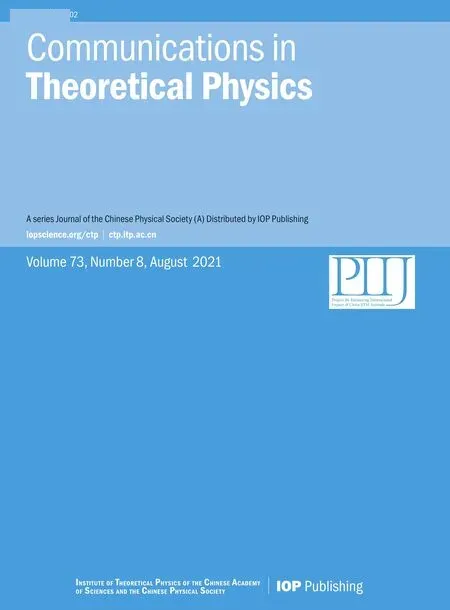Balanced biosynthesis and trigger threshold resulting in a double adder mechanism of cell size control
2021-08-18LeileiLi
Leilei Li
1 CAS Key Laboratory of Theoretical Physics,Institute of Theoretical Physics,Chinese Academy of Sciences,Beijing 100190,China
2 School of Physical Sciences,University of Chinese Academy of Sciences,Beijing 100049,China
Abstract How cells accomplish cell size homeostasis is a fascinating topic,and several cell size regulation mechanisms were proposed:timer,sizer,and adder.Recently the adder model has received a great deal of attention.Adder property was also found in the DNA replication cycle.This paper aims to explain the adder phenomenon both in the division-centric picture and replication-centric picture at the molecular level.We established a self-replication model,and the system reached a steady state quickly based on evolution rules.We collected tens of thousands of cells in the same trajectory and calculated the Pearson correlation coefficient between biological variables to decide which regulatory mechanism was adopted by cells.Our simulation results confirmed the double-adder mechanism.Chromosome replication initiation and cell division control are independent and regulated by respective proteins.Cell size homeostasis originates from division control and has nothing to do with replication initiation control.At a slow growth rate,the deviation from adder toward sizer comes from a significant division protein degradation rate when division protein is auto-inhibited.Our results indicated the two necessary conditions in the double-adder mechanism:one is balanced biosynthesis,and the other is that there is a protein trigger threshold to inspire DNA replication initiation and cell division.Our results give insight to the regulatory mechanism of cell size and instructive to synthetic biology.
Keywords:cell size control,cell size homeostasis,cell cycle,growth law,double adder,critical initiation size,single cell
1.Introduction
Cell size control is an important topic in bacterial physiology[1].Bacterial volume has a wide range,spanning over seven orders of magnitude,from 0.01 μm3[2]to 2×105μm3[3],and bacteria have various cell shapes,such as coccus(spherical),bacillus(rodshaped),and spiral(twisted)[4].Despite this diversity,individual organisms have a preferred size with a very narrow distribution,like E.coli with a coefficient of variation,CV=s.d./mean,of birth cell size distribution only being 10%[5,6].The phenomenon is called cell size homeostasis.Individual cell size homeostasis was also found in animals[7,8]and fission yeast[9].How to control cell size to a stable and narrow distribution,and the molecular mechanism of cell size control count for much in cell biology[10].
The cell volume can be measured at the population or single-cell level.In 1958,Schaechter,Maalφe,and Kjeldgaard found a relationship between growth rate and cell volume named Schaechter–Maalφe–Kjeldgaard(SMK)growth law[11,12].The growth law was also called as nutritional growth law,confirmed by Sattar Taheri-Araghi et al[13]at the singlecell level.The nutritional growth law indicates that the average cell birth volume increases exponentially with the growth rate in different given growth condition.That is:

where V is the average birth volume,μ the growth rate,Y and X being growth-rate-independent constants.The SMK growth law was interpreted as a result of cells adapting to the external condition[14–16].Larger cells with faster growth rates possess more DNA and more cytoplasm[12].Another important result of the SMK experiment is that cells growing at different growth rates have different chemical components.The logarithms of cell constituents(protein per cell,DNA per cell,and RNA per cell)are proportional to the growth rate.It should be noted that the growth rate μ in the SMK growth law is the population exponential growth rate,and it is different from the elongation rate at single-cell level.The population growth rate is the ensemble average of the elongation rate.The SMK growth does not mean that cells with faster elongation rate have a lager volume in the same culture condition.Cell homeostasis is a conception in same culture condition.So the SMK growth law does not contradict size homeostasis.How cell size and cell components are determined by cell growth rate is one of the major topics to be investigated in the field of bacterial physiology.
Cell size control has to accommodate with cell cycle,which determines when to initiate DNA replication,when to complete DNA replication,and when to divide[17,18].In 1968,Donachie[19]put forward a vital model,indicating that:

where V(τ)is the average cell size at the birth time or called constant initiation size,V0the average cell size per origin(Origin means the origin of replication,a specific DNA sequence in a genome at which replication starts.)at the time of DNA replication initiation,C the duration of replication,D the time to segregate the chromosomes and divide,and τ average cell doubling time.C+D is about 60 min in experiments between replication initiation and cell division called cell cycle time.In our work,the cell cycle time is defined as chromosome replication cycle time,which is from the initiation of DNA replication to the sister chromosomes segregation.It is different from doubling time or generation time,which is the time between two consecutive divisions.Donachie’s work was based on two cornerstone assumptions[20,21]:(i)the chromosome replication time(C period)is a constant during the steady growth in whatever growth condition;(ii)the time between replication initiation and cell division(C+D period)is a constant.In 2015,Sattar Taheri-Araghi et al[13]examined Donchie’s model at the single-cell level.Under extensive growth inhibition conditions,cell size at replication initiation per origin is also invariant[22].
There are three theoretical models to interpret how cells control their cell size:adder[13,23],sizer[24],and timer[25].Adder regulation means that cells add a fixed increment between two division events,sizer regulation meaning that cell division or chromosome replication begins when cell size reaches a critical value,and timer means the time across the cell cycle is a constant.Assuming the correlation between mother and daughter birth sizes is α,then the daughter cell size can be expressed by the following formula[17,18]:
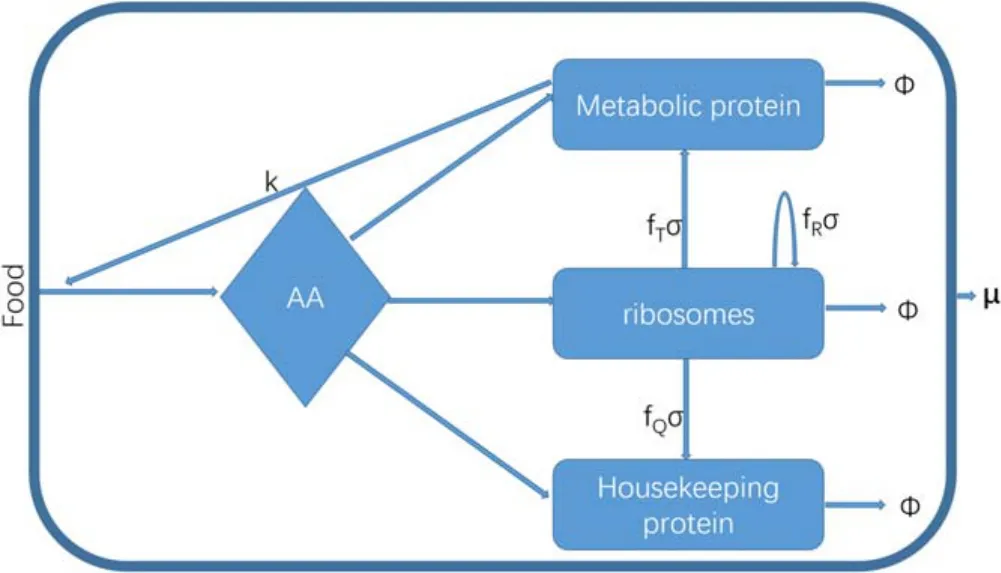
Figure 1.A coarse-grained model of the cell.Extracellular food is transported into the cell and is decomposed into amino acids(AA)by metabolic proteins.Amino acids are assembled into various proteins by ribosomes and are allocated to metabolic proteins,ribosomes,and housekeeping proteins reasonably to get a maximal growth rate.→φ means the degradation of proteins.μ is the growth rate.

where V+1is the daughter birth size,V0the mother birth size,Vmthe population average birth size,and ξ Gaussian white noise.If cells grow exponentially,then timer regulation results in α=1,adder regulation resulting in α=1/2,and sizer regulation resulting in α=0.So the correlations between birth size and division size can be used to distinguish three models.With single-cell technology development,it is easy to get the correlations between birth size and division size,as well as the correlations between birth size and interdivision time.Recently researches have demonstrated that bacteria achieve cell size homeostasis through adder model[13,23,26–29].
The adder property is of core importance in the field of bacterial physiology[30].There are many phenomenological models[28,31–33]explaining the adder property,the correlation between birth volume and division volume,and the correlation between inter-division time and birth volume.Recent studies[34,35]have demonstrated the adder property arises in not only the birth-division process but also the DNA replication cycle.These works showed that the adder property requires protein accumulation to a threshold to begin DNA replication or cell division and balanced biosynthesis during cell elongation.In the following sections,we will affirm the double-adder model in silicon.
2.Model
We established a model like Precursor–Transporter–Ribosome cell model in the works[30,36,37].We considered the cell model containing four sectors:precursors,metabolic proteins,ribosomes,and housekeeping proteins,as displayed in figure 1.Precursors molecules consist of 20 kinds of amino acids.Metabolic proteins include transporter transporting the external food into the cell and proteins converting food into amino acids.Ribosomes are self-catalytic proteins,making amino acids into various proteins.Housekeeping proteins are proteins that maintain the physiological stability of cells.The proportion of housekeeping proteins is considered to be a constant.
The model is described by the following set of differential equations:
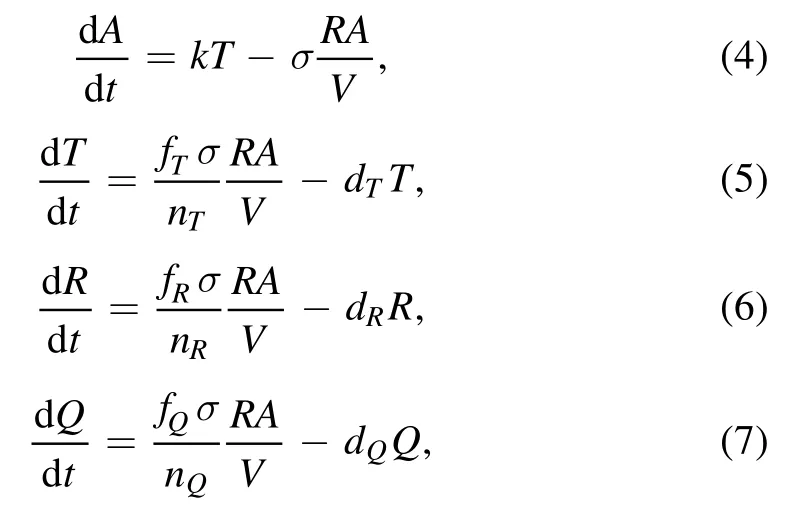
where A represents the number of precursors molecules or amino acids,T the number of metabolic proteins including transporter proteins transporting food into the cell and proteins converting food into precursor,R the number of ribosomes and Q the number of housekeeping proteins.V is the cell volume:

where g means unit mass protein occupying volume,it is reasonable to assume that g is a constant because the variation of cell dry-mass density is very small[38].mAis the average mass of a single amino acid,and nT,nRand nQare the average numbers of amino acids consisting of metabolic proteins,ribosomes,and housekeeping proteins,respectively.k represents the efficiency of metabolism,which is a function of external food concentration and food quality.σ is the ribosomal catalytic efficiency,the rate of amino acid consumption for a single ribosome per unit amino acids concentration.dT,dRand dQare the degradation rate of metabolic proteins,ribosomes,and housekeeping proteins,respectively.fT,fRand fQrepresent the fractions of ribosomes engaged in making metabolic proteins,ribosomes,and housekeeping proteins,respectively.Their sum satisfies:

where fQis a constant.
When cell grows exponentially with a growth rate μ,it is easy to get a quadratic polynomial expression of growth rate:

where the coefficients a0,a1and a2depend on the food concentration,food quality,physical constants,and ribosomal catalytic efficiency,defined in the appendix.Its solution proves Monod growth law[39]:

where ρ,ν are defined in appendix.
Now we introduce trigger proteins.I and D are the molecules that control DNA replication initiation and cell division respectively.Their dynamics are determined by
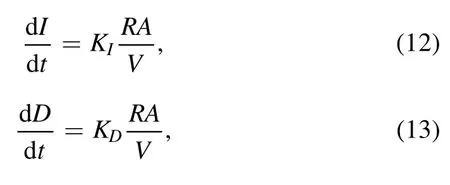
where KIand KDare rate constants.When the number of I or D reaches a threshold respectively,chromosome replication or cell division begins.Because the number of DnaA and the number of FtsZ per cell are very limited[40,41],the mass of cell size regulators is negligible to the whole cell.As the equations(4)–(13)show that the number of chemical population is proportional to cell size V,so that the production rate of chemical population is proportional to cell size V.We referred to our model as an ATRQID system.
Our model has many limitations.Our model does not include the complete genetic central law.We did not consider the effect of gene copy number on transcription rate and translation rate[42].The sources of gene expression noise are very extensive and complex.Our model is too simple to consider so many influencing factors.
3.Deterministic results
As the parameters of the dynamical system ATRQID sector are specified and chemical populations are given initial values,the system will go on forever.The deterministic dynamic of the ATRQID system is discussed in this section,and the stochastic dynamic will be discussed in the following sections.
Thus,as the number of DNA replication protein I per origin reaches the threshold Ic,DNA replication begins,and I per origin degrades to Ir(Ir As shown in figures 2(a)and(b),after a short transitional state depending on the initial condition,the chemical populations gathered to a steady state independent of the initial condition.The population number and cell volume got to maximum when the number of cell division proteins got to the threshold,and chemical population and cell size were halved.The dynamics system was an attractor making the populations grow at the same rate,i.e.the numbers of various proteins doubling times are the same,as displayed in figure 2(d). Figure 2.The deterministic trajectories of chemical populations,P,T,R,Q,I,D and volume V versus time t.Parameters of the ATRQID system are k=3000 h−1,σ=3∗10−5 μm3 h−1,KD=4∗10−12 h−1,KI=6∗10−12 h−1,dR=dQ=dT=0.1 h−1,Dc=200,Ic=200,Dr=0,Ir=0,and the other parameters of the model are shown in the table 1.The population values in(a)and(b)have been adjusted to make all of populations shown on the same figure by some multiplier factors.(a)The trajectory of populations versus time in a cell with the initial condition IC1:A(0)=103,T(0)=105,R(0)=103,Q(0)=104,I(0)=20,D(0)=10.The populations’dynamics evolve to a steady state,and the chemical populations in the daughter cell at the birth are Ab=1.28∗109,Tb=8.39∗105,Rb=5.26∗104,Qb=1.71∗106,Ib=88,Db=0.The doubling time is 0.7235 h.(b)The trajectory of populations versus time in a cell with the initial condition IC2:A(0)=109,T(0)=3∗106,R(0)=5∗104,Q(0)=5∗106,I(0)=10,D(0)=100.The population dynamics reach a same steady state as IC1.(c)The plot of cell size versus time on the two initial conditions IC1 and IC2.(d)The 2D space of Q/R and T/R shows that the trajectories converge to the same attractor independent of initial conditions. As displayed above,we made a deterministic simulation of the dynamics trajectories of the ATRQDI cell.Now we show the stochastic version as posed in figure 3.The differences between the deterministic version and the stochastic version are:(i)the population’s number is an integer and updated by Gillespie algorithm[43,44],(ii)the DNA replication protein threshold is a random variable following Poisson distribution with mean Ic.When I reaches its target,the chromosome replication begins,the number of origins doubles,then I is broken down to Ir(Ir We found that after several cycles of growth,division,and birth,the system got to a steady state,where all of the chemicals have balanced biosynthesis.Different from the deterministic version,the daughter cell in the stochastic simulation is not the same due to stochastic initiation and division.The parameters in figure 3(a)are the same as those in figure 2(a). Figure 3.The stochastic trajectories and the scale-free property of cell size.(a)The stochastic trajectories of chemical populations,P,T,R,Q,I,D and volume V versus time t.Parameters of the dynamics systems are k=3000 h−1,σ=3∗10−5 μm3 h−1,KD=4∗10−12 h−1,KI=6∗10−12 h−1,dR=dQ=dT=0.1 h−1,Dc=200,Ic=200,Dr=0,Ir=0,and the other parameters of the model are shown in the table 1.The population values in figure 3(a)have been adjusted to make all of populations shown on the same figure by some multiplier factors.(b)The frequency distribution of cell division size,birth size,added size,and inter-division time in the steady state.The average division cell size〈Vd〉is 3.279 μm3,average birth cell size〈Vb〉=1.642 μm3,average added cell size〈Δ〉=1.637 μm3,average division time〈τ〉=0.723 h.(c)The frequency distribution of cellular variables is re-scaled by their respective means.The curves denoted by cell division size,cell birth size,added size and doubling time stand for Vd/〈Vd〉,Vb/〈Vb〉,Δ/〈Δ〉and τ/〈τ〉.The coefficient of variation of those cellular variables are 0.071,0.093,0.113,0.094. Table 1.The dynamics parameters and biological constants in the ATRQID system. A surprising phenomenon is that the distribution of cell birth size is only the function of the mean cell size both in the intra-species[13]and inter-species[45]level.This phenomenon implies that most cells share the same division mechanism,so the distribution of cell birth size can be rescaled by the average birth size.The growth rate cannot be rescaled by the mean growth rate[46].Because the growth rate influences the age distribution of cell,so the cell size distribution of population snapshot data and the cell size distribution of cell lineage data are growth rate-dependent.The article[13]displays that the relationship between the variation of cell division size,birth size,added size,and inter-division time is expressed by: where Vdis the cell division cell,Vbcell birth size,Δ=Vd−Vbadded size or the cell size increased between division time,and τ doubling time.We performed 20 000 stochastic division simulations for our model with the same condition in figure 2(a);then,we tracked the cellular variables for all the cells in one trajectory.We observed the averages of the steady state as shown in figures 3(b)and(c):the average division cell size〈Vd〉=3.279 μm3,average birth cell size〈Vb〉=1.642 μm3,average added cell size〈Δ〉=1.637 μm3,average division time〈τ〉=0.723 h.The coefficient of variation of those cellular variables are 0.071,0.093,0.113,0.094 respectively,while the work[13]showed that CV of four quantities are 0.12,0.139,0.156,and 0.2,respectively.Our noise results are smaller than work[13].CV of added size is biggest,and CV of division size,birth size,and doubling time are approximately the same.The results are similar with work[13].So our results are not all consistent with the article[13].It is maybe because we did not consider the noise of growth rate[47]. Figure 4.The cell birth size distribution versus cell size distribution of lineage data.(a)In the same lineage,the distribution of tens of thousands of consecutive cells at birth.Three distributions are used to fit this distribution,namely:Gaussian distribution,gamma distribution,and lognormal distribution.(b)In the same lineage,the cell size distribution of cell lineage data for dozens of consecutive generations. Figure 5.The division-centric picture and the replication-centric picture of the cell cycle.(a)In the division-centric picture,the cell cycle is separated into three periods.The first period is from cell birth to initiation of DNA replication,named B period.The second period is the time interval DNA replication occupies,called C period.The last one is from the completion of the chromosome of replication to cell division,named D period.DNA replication begins at the origin when the cell size reaches a critical volume Vi and ends at the terminus.(b)The replication-centric picture is defined as two consecutive chromosome replication initiations.It is worth noting that(b)is only tenable at a slow growth rate.When doubling time is shorter than C+D,there will be more than one round replication in the cell.All the biological variables are defined in table 2. What is the distribution of cell size at birth is a very controversial issue.As shown in the figure 4(a),we used three distributions to fit our data.Like most experimental data,our data does not distinguish these three distributions very well.Cell size distribution of lineage data is a quirky curve[48].Fortunately,as displayed in figure 4(b)our simulation results captured the three most important characteristics of this distribution:when it is smaller than the most probable size of the cell,the number of cells rises rapidly;after that,the number of cells begins to decrease slowly;when the cell size reaches a certain value,the number of cells begins to decrease rapidly. When we analyze bacterial physiology,there are two pictures:one is paying close attention to the cell division,and the other is focusing on DNA replication.We drew a simple diagram figure 5 to show the differences between the two pictures.The relationship between cell division and cell cycle is vital and studied extensively. When we research the question about cell size,using the division-centric picture is natural.In the picture,the period is from cell birth to cell division.The Pearson correlations between cell birth size,cell division size,doubling time,and added size are used by investigators to estimate which size regulation mechanism is adopted by cells.Another two important variables are chromosome replication initiation time and completion time.From cell birth to replication initiation is named B period,the time to replicate the chromosome C period and the time replication completion to cell division D period.In general C period and D period are thought independent,and C+D is a constant[19].But recent researches dedicates that C+D is growth-rate-dependent[34,49]. What is different from the division-centric picture is that the replication-centric picture is from replication initiation to the subsequent replication initiation.Recently more and more researchers began to realize the importance of cell size regulation in the replication-centric picture[18].Amir[18]believes that there is no specific cell size regulatory mechanism,and cell size homeostasis originates from the control of chromosome replication. Figure 6.The Pearson correlation coefficients and slopes between various variables in the division-centric picture.Each point stands for one cell in 20 000 consecutive divisions after the system gets into the steady state.The red line is the linear fitting curve.(a)The X-axis refers to the cell birth volume,and the Y-axis refers to the increased volume during the division cycle.In the ideal adder model,the correlation coefficient of Vb andΔshould be 0.Our result is−0.050,so that add property is proved in our model.(b)The correlation coefficient of Vb,volume at birth time,and Vd,volume at division time,is 0.760.The slope of the fitting curve is about 1.(c)The doubling time τ is negatively correlated with birth size.In the ideal adder model,the correlation coefficient should be−0.5,compared with our model−0.531.(d)The replication initiation size Vi is positively correlated with Vb with the correlation coefficient being 0.259.If Donchie’s hypothesis is correct,the value should be 0. The adder property between cell division is one general phenomenon that is still required to explain.The adder property also emerges between consecutive replication initiation[34,35].In the following sections,our work will reveal the adder property is only based on two basic assumptions:(i)a fixed number target of cell division protein to trigger division,a threshold of DNA replication protein to touch off replication,and then proteins are degraded or deactivated.(ii)All the chemical populations are produced by a rate proportional to the cell size,i.e.balanced biosynthesis.So we got the conclusion that not only cell division but also DNA replication was important to cell size regulation,but cell size homeostasis was irrelevant to chromosome replication initiation. We collected 20 000 cells in one stochastic trajectory,and then we gathered the biological quantities,including the chemical population numbers,cell size,origin number at cell division time,and chromosome replication initiation time.After that,we calculated the mean chemical population numbers,mean cell size,the distribution of cell size at different important time nodes.By using 20 000 successive cells in one trajectory,we computed the Pearson correlation coefficient between added volumeΔ,division volume Vd,doubling time τ,cell size at replication initiation,and birth cell size Vb,displayed in figure 6.We found that the ATRQID system displayed the adder property,the mean added volume Δindependent of birth cell size.We found a significant result that the birth size was positive correlative with cell size at DNA replication initiation.This conclusion does not support the constant initiation mass assumption[19,34,37,50]by Donachie in 1968.So the chromosome replication initiation is not controlled by cell mass but rather the number of replication initiation protein.Our result is consistent with work[34]. As the same as the division-centric picture,using 20 000 successive cells in one trajectory,we computed biological variables in the replication-centric picture.As defined in table 2 and shown in figure 5,volume per origin at replication initiation is Si=Vi/2,volume at final replication initiation Sfbeing same as the volumeat next round of replication initiation,added volume between replication cycle Δif=Sf−Si.It is worth reminding that for the sake of succinct definition of Sf,We only considered the situation where there is only one replication in a division cycle.We did not consider faster-growing condition in which there are overlapping rounds of replication.In the next division cycle,the two daughter cells total size is about2*so that Sfis defined asrather thanWe then computed the Pearson correlation coefficient between replication added size,final replication initiation size,time C+D with replication initiation cell size per origin,and auto-correlation coefficient of replication initiation cell size per origin,displayed in figure 7.We found that the ATRQID system showed the replication cycle adder property,the mean added volume between replication cycleΔindependent of volume per origin at replication initiation.The auto-correlation coefficient of replication initiation cell size per origin is positive and about 0.5.If Donchie’s assumption is right,the autocorrelation coefficient should be 0.So in the replicationcentric picture,we also reject the constant initiation mass hypothesis. Figure 7.The Pearson correlation coefficients and slopes between various variables in the replication-centric picture.Each point stands for one cell in 20 000 consecutive cells after the system gets into the steady state.The red line is the linear fitting curve.(a)The increment between cell replication cycleΔif is uncorrelated with volume Si at replication initiation per origin.This result certificates the adder property in the replication-centric picture.(b)The correlation coefficient between the volume Si at the initial replication initiation per origin and the volume Sf at the final replication initiation per origin is 0.561 and the slope of the curve 1.123.(c)The time between replication initiation and cell division C+D is negatively correlated with Si.(d)The auto-correlation coefficient of Si is 0.562.If Donchie’s hypothesis is right,the value should be 0. In order to test and verify Amir’s hypothesis[18,28]that replication and division are regulated together,we set the DNA initiation protein synthesis rate constant to a periodic function with a period 2τ.If replication and division control are co-regulated,as the replication initiation mass changed,the division mass will change in the same direction.A smaller birth size is,a bigger added size generates.The cell will behave like a sizer.But our stochastic simulations do not support co-regulation assumption,and our results confirm the experiment[35]by Si et al.As displayed in figure 8,the oscillation of DNA initiation protein expression does great damage to replication adder,but it does not destroy division adder.Cells in the replication picture are divided into twoparts because the oscillation period is twice of division time.Due to the oscillation of synthesis rate,the accumulation time of replication initiation proteins is different,resulting in different replication initiation sizes.Our results imply that the regulations of replication and division are independent,and the division timing is only regulated by division protein. Table 2.Variables definitions. In this section,we let the division protein synthesis rate constant oscillate periodically with period 2τ.The production rate of division protein influences the doubling time and division size.Cells are divided into two portions because of different division protein accumulation times.So oscillation of division protein expression ruins the adder property.As shown in figure 9,the replication adder is without affecting.This result indicates that the replication and division control independently.Our results displayed in figures 8 and 9 comply with work[35]. It was reported that E.coli exhibited sizer property at slow growth and adder property at fast growth rate[51].The smaller the birth size is,the bigger the added volume.Why does this phenomenon appear?Si et al[35]hold the viewpoint that the considerable degradation rate of FstZ reduces the auto-correlations of FstZ and division size,and cells deviate to sizer from adder.We made three groups of simulations:no auto-regulation,positive auto-regulation,and negative auto-regulation to confirm the idea.As displayed in figure 10,when the division proteins have a negative autoregulation and the division protein degradation rate is not zero,cells represent a mildly deviation from adder toward sizer.Besides,when there is no auto-regulation,no deviation from adder will appear.Because of the bistability property of positive auto-regulation,it is possible the division protein synthesis rate is lower than the degradation rate forever.Bistability means that the system has two stable equilibrium states.Under positive feedback,the production rate of division protein is a hill function.The system have three fixed points.The fixed point wherever production rate is equal to degradation rate is unstable.When production rate exceeds degradation rate,division protein will increase,and cell can divide normally.Otherwise division protein will decrease,and cell can’t divide forever.So under the positive autoregulation condition,there is a considerable probability that cells never divide.It is reasonable to infer that deviation from adder originates from the non-negligible division protein degradation rate. Figure 10.The Pearson correlation coefficients and the slopes between birth size and added size when division protein degradation rate is zero or not zero,and cells have an auto-inhibition mechanism.Parameters of the dynamics systems are k=3000 h−1,σ=3∗10−5 μm3 h−1,KD=[200/(200+d)]∗10−11 h−1,KI=7∗10−12 h−1,dR=dQ=dT=0.1hr−1,and the other parameters of the model are shown in the table 1.(a)The degradation rate of division protein dD is 0.Cells represent adder property.(b)The degradation rate of division protein dD is 1hr−1.Cells slightly deviate from adder property to sizer property. An important issue is how cell counts the trigger protein number or why there is a trigger threshold.In our work,we did not refer to which protein the trigger protein is.In general,the replication protein is thought DNAa.It is reasonable to assume there is a threshold proportional to the origin number.The division protein is always thought FstZ.In the paper[38],authors believe that FstZ amount gets to a threshold proportional to cell diameter,while the diameter of a cell is a constant in a specific growth condition.So it is reasonable to assume there is a threshold to trigger the cell process.There are several cell size regulators,including DNAa,FstZ,and MreB,but we do not have a systematic view on cell size regulation.More experiments to find cell size regulators and more models are needed. It is weird to suppose trigger proteins degrade or deactivated to a constant[33,52].We notice that the two-component model is prevailing in replication initiation and cell division systems[38,53,54].So after the trigger,the trigger proteins turn into the free state from the binding state,and the number of binding state proteins deactivates to a constant. In our model,every chemical population is proportional to cell volume.But in fact,contents in the membrane proportion is a nonlinear function of cell size.Recent researches[55–57]indicated importance of surface area to volume in the cell size regulation.It is noteworthy that cell wall production is balanced biosynthesis at single-cell level[58].How cells achieve balanced surface biosynthesis,and the effect of the membrane in cell size regulation are interesting topics. We did not consider the constraint between KD,KIand σ,k,so it is not suitable to solve questions in different growth rates.Such as,in the paper[59],authors hold the opinion that the trigger protein production rate is proportional to 1/C,1/D,or 1/(C+D)where C is the DNA replication time,and D is the time from replication completion to cell division.In future work,it is possible to check SMK growth law and compute the time between replication initiation and cell division in the various growth rates.Whether the DNA replication regulation and division control are interconnected is an interesting question. Because our work is a self-replication model,the cells grow exponentially.As we know,yeast displays linear growth trajectories[60].In work[61],authors think linear growth originates from limiting mRNA and DNA.It is valuable to study how cells show non exponential growth and cell size regulation at linear growth. Cell size noise comes from the stochasticity of chemical reactions,the random partition of cell division,and the fluctuation of single-cell growth rate[47].We did not consider the growth rate noise.The current model[42,48]can consider elongation rate noise by dividing cell cycle into many stages.How to combine current model with our model is question worth thinking.Single-cell growth rates do not show linear scaling with respect to the mean[46].The origin of growth rate noise is unclear,and the influence of growth rate on cell size control is an unanswered question. The properties of auto-regulatory gene networks are wellstudied[62–66].But we do not know the relationship between subcellular feed back mechanism with the cell size control mechanism.In future,more research should be focused on the field. Altogether,we developed a self-replication model based on work[30,36,67],and we added the housekeeping protein and chromosome replication section.We have presented some analytic and numerical results.In the analytical section,we tested Monod growth law.The system we founded evolved to a steady state quickly by our evolution rules and chemical populations,cell size reached homeostasis.By using tens of thousand cells in one evolutionary process,we computed the Pearson correlation coefficient between variables.The correlations have been used to determine which regulation mechanism is adopted by cells.We confirmed the experiment results[34,35],double-adder mechanism that cells display adder property both in the division cycle and replication cycle.Chromosome replication initiation control is of importance to cell size control because initiation control decides the initiation mass,which determines the unit cell,while the average birth cell size is the sum of unit cells[49].Although the importance of replication initiation in cell size control,initiation control does not contribute to cell size homeostasis.DNA replication initiation regulation and cell division regulation are independent,and cell division control drives homeostasis regardless of how the chromosome replication initiation is regulated.E.coli at slow growth rate appearing a mildly deviation to sizer from adder is because that the division protein degradation rate is tremendous.In summary,we have implemented a double-adder mechanism in silicon based on two assumptions:(i)there are trigger thresholds for replication initiation and cell division,and after triggering events,the corresponding proteins are degraded to a constant;(ii)chemical populations production rate is proportional to the cell volume,that is,balanced biosynthesis. Cell size control is valuable to bacterial physiology,and we only know the tip of the iceberg.Understanding the interconnection between cell size regulation,growth rate,division cycle,and replication cycle is complicated and attractive.The reason cells deviate from the adder model is an essential issue for an urgent discussion.A long-term evolution experiment[68,69]reveals that more giant cells are,a growth rate faster,and the fitness more significant.The relationship between cell size and fitness is worth studying. Acknowledgments We are grateful to professor Hualin Shi for the constructive modification suggestions of this manuscript.We thank Docter Fulin Deng for suggestions on language modification. Appendix A.Formula derivation Equations(10)–(11)are inferred as following: When the system gets to steady state,all the chemical population chemicals grow exponentially: where μ is growth rate.Substituting this relations into equations(4)–(7),we get Equation(A.7)gives equations(A.6)–(A.7)give equations(A.7)–(A.8)give Substituting equations(A.9)–(A.10)into(A.5),we get We rewrite equation(A.9) We rewrite V/A by equation(8) Substituting equations(A.10)–(A.12),(A.14)into(A.13),we get where where ρ,ν are defined by we ignore the small item,and let degradation rate be 0.We get while the amino acid production rate is approximately equal to amino acid consumption rate, we get Appendix B.Numerical method Our numerical computations were implemented in Matlab.Differential equations were solved by four order Runge–Kutta algorithm.Stochastic simulations were implemented by Gillespie algorithm and τ-leaping methods[43,44].The specific implementation process is as following: Step 1:Initialization.Make assignments to chemical populations,reaction kinetic parameters,and time t=0. Step 2:Calculate the propensity function of each reaction and get parameters ai. Step 3:Generate the the reaction leaping time τiby τleaping methods.If τiwas greater than 0.001 s,then τiwill be set to be equal to 0.001 s. Step 4:Update chemical populations by a Poisson distribution,and time t=t+τi. Step 5:Judge whether replication initiate or divide and update chemical populations. Step 6:If initialized time met,finish the stochastic simulations.If not,go to step 2.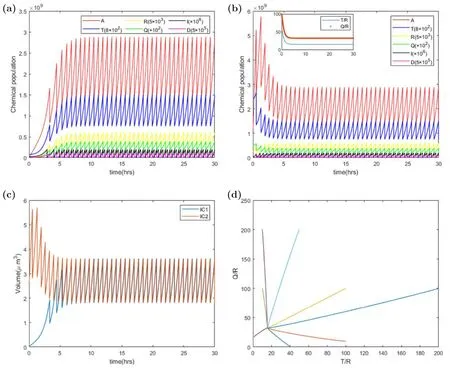
4.Stochastic numerical results

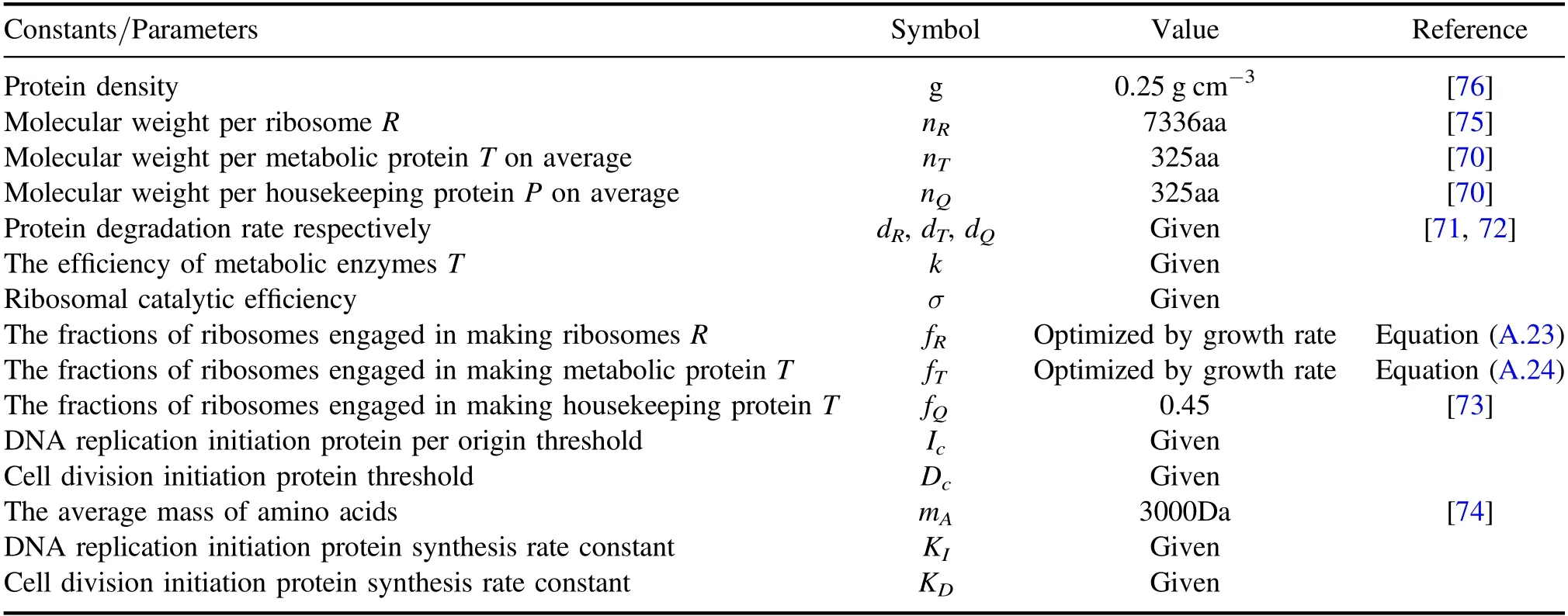

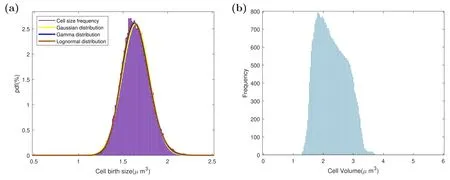

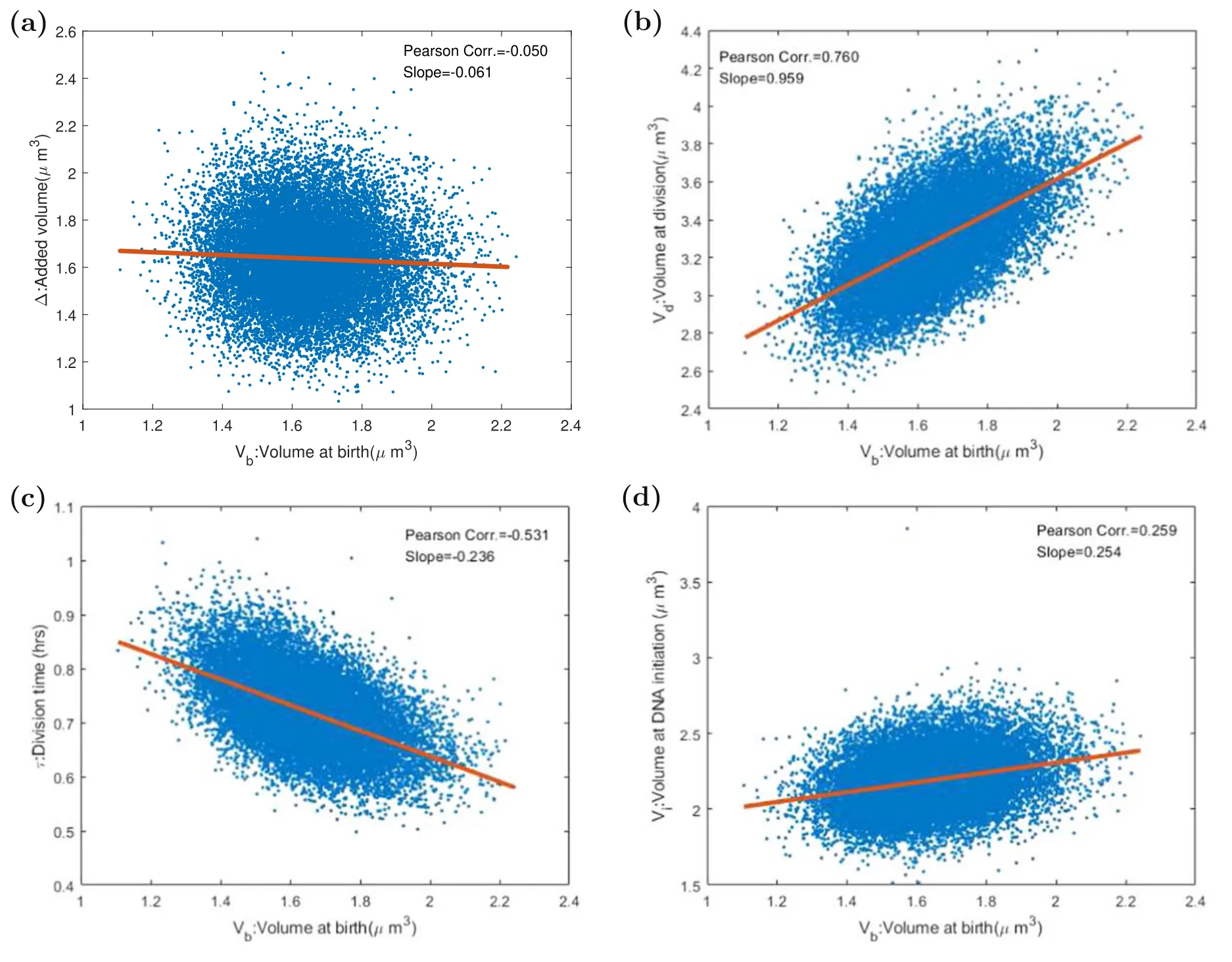
4.1.The adder property of division-centric picture
4.2.The adder property of replication-centric picture
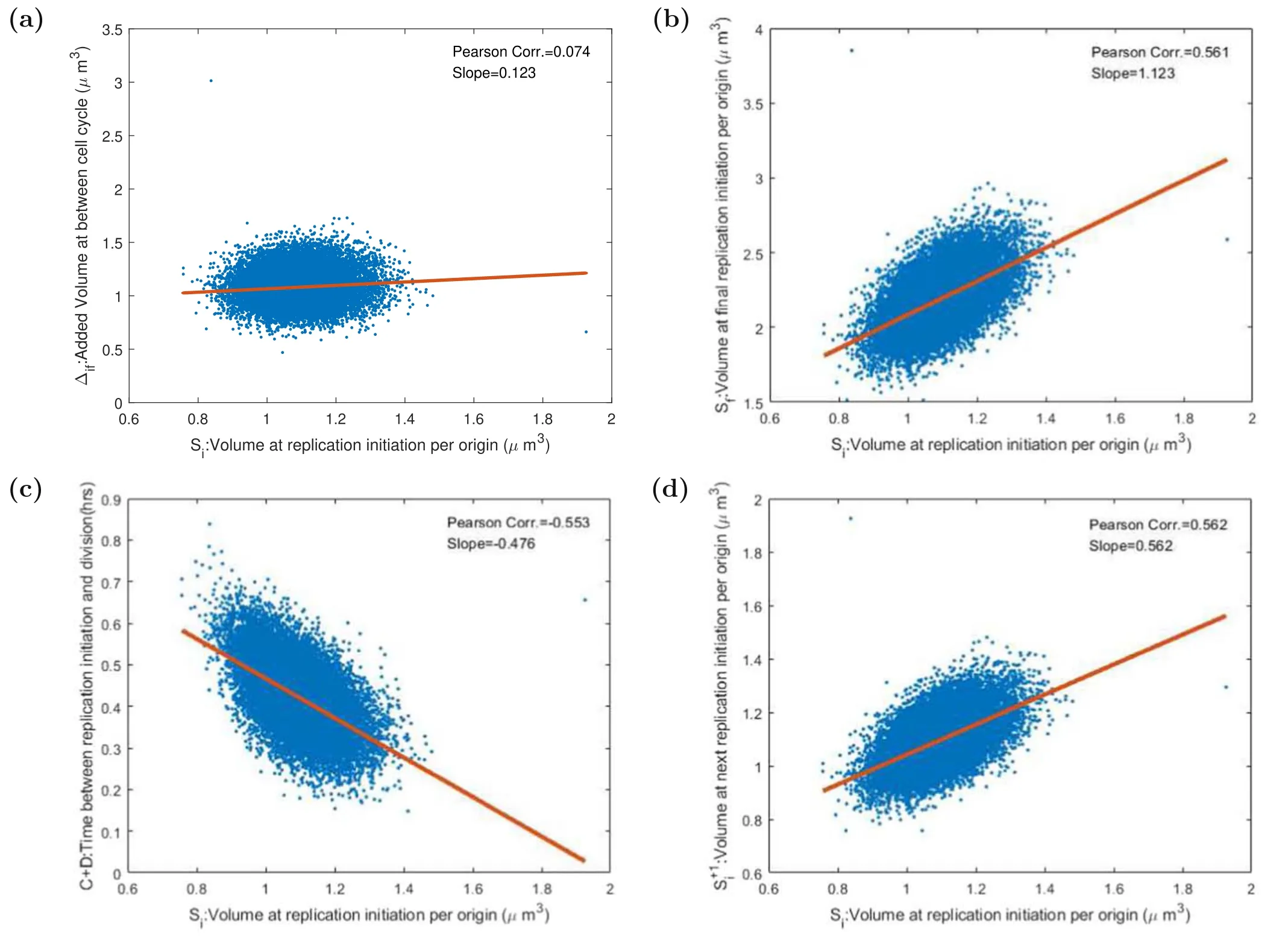
4.3.Oscillation of DNA initiation protein expression
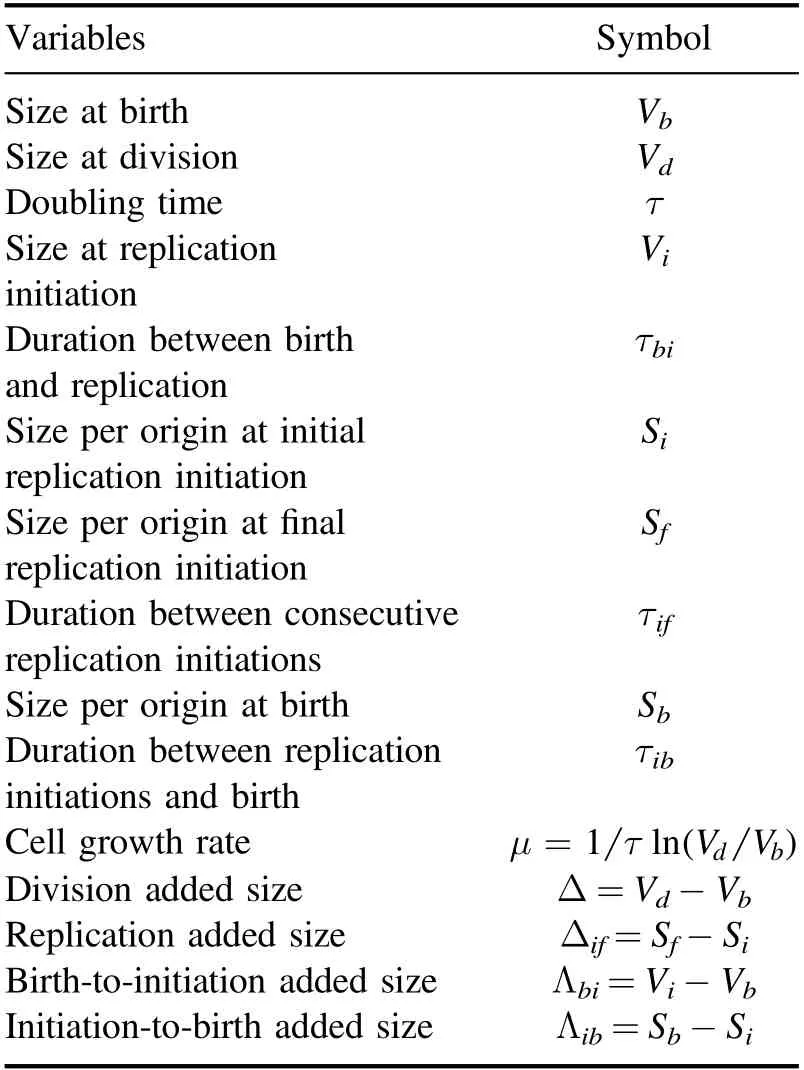
4.4.Oscillation of division protein expression
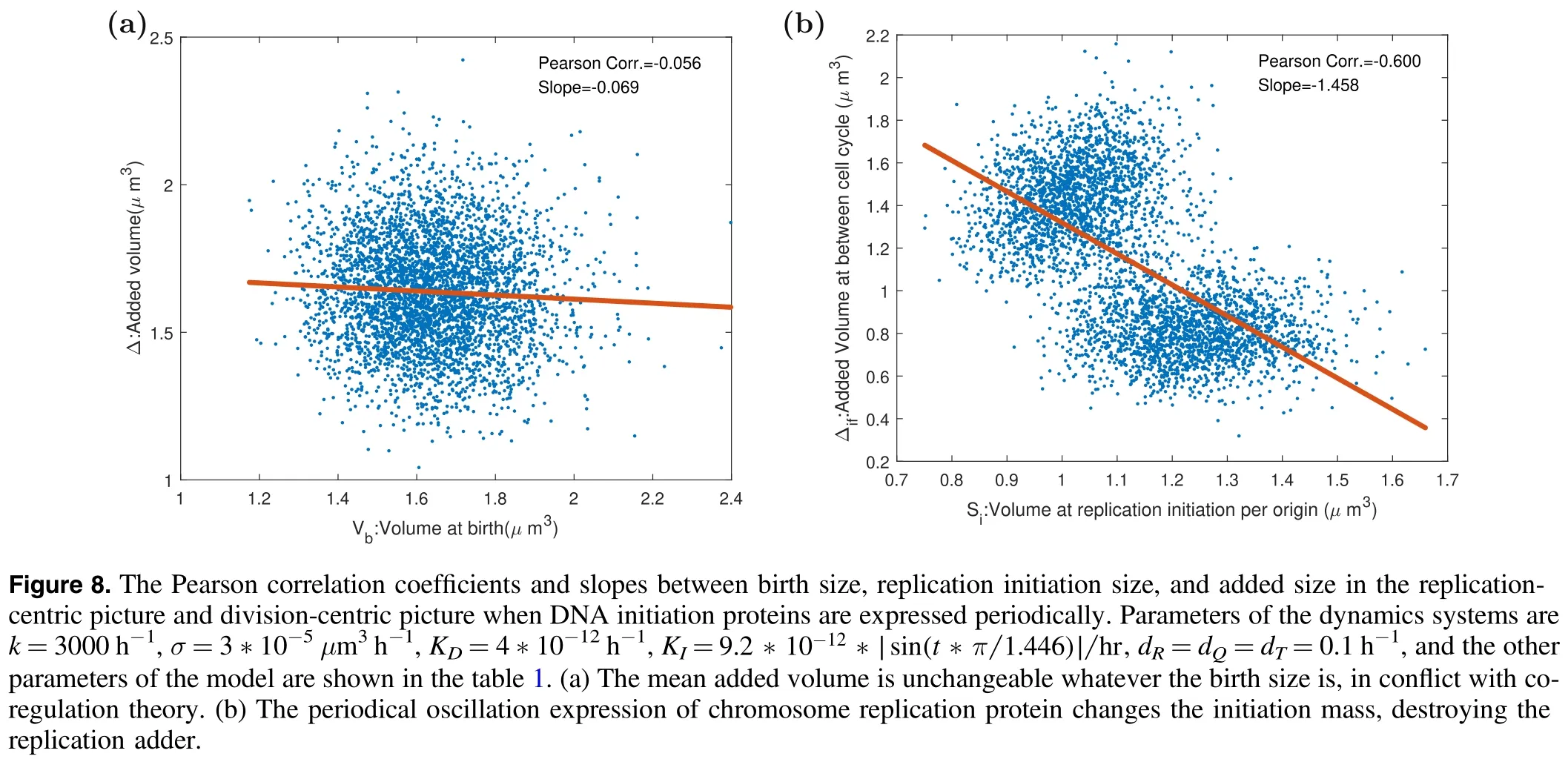
4.5.Deviation from adder toward sizer at slow growth rate
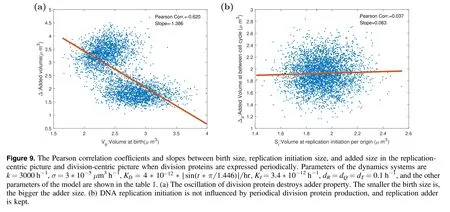
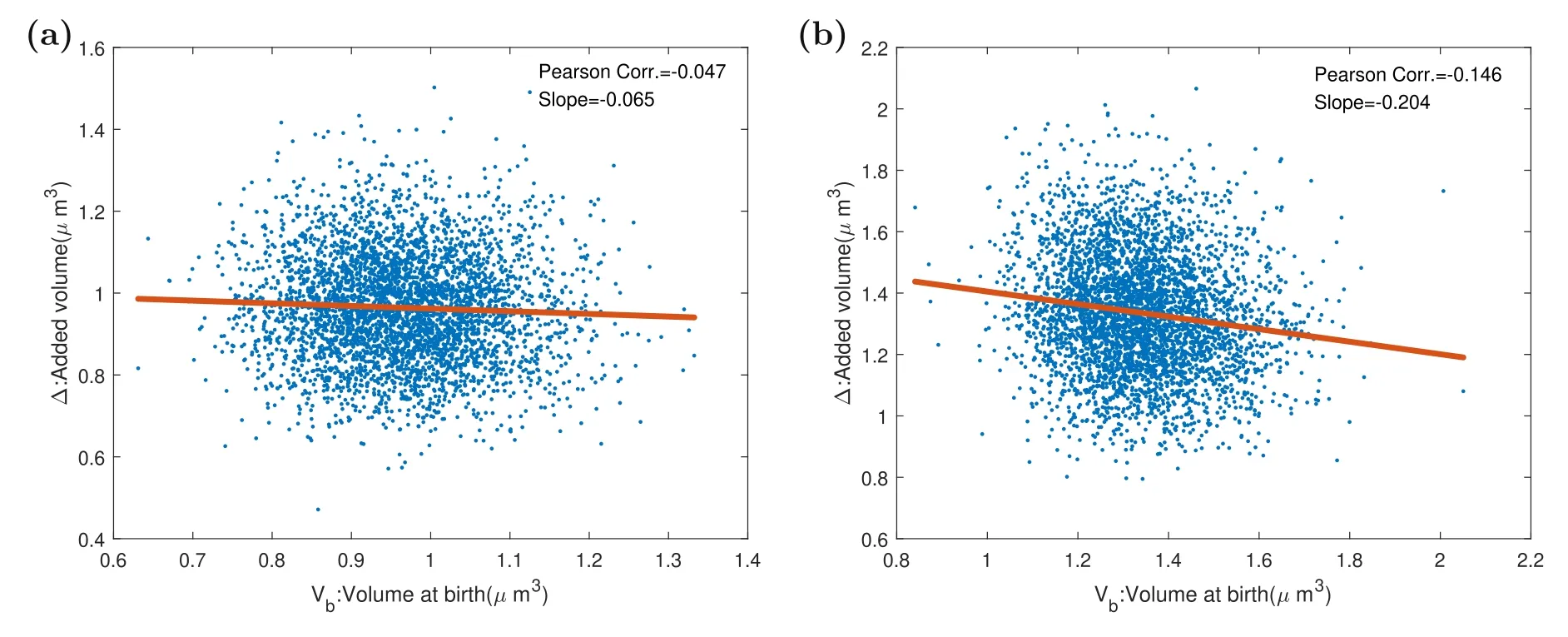
5.Discussion
6.Conclusion
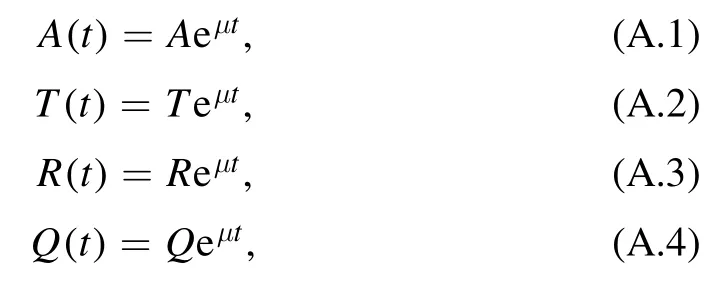
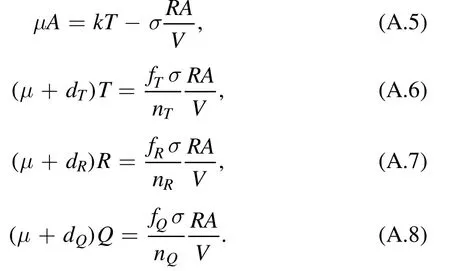







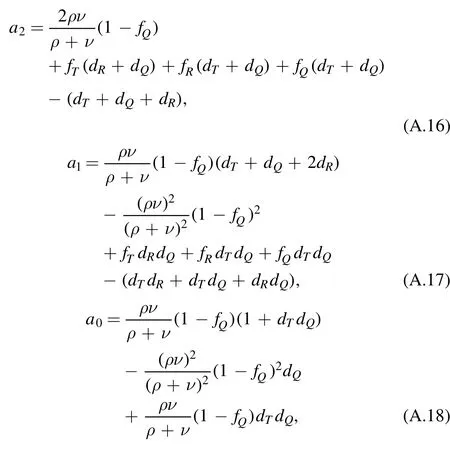




杂志排行
Communications in Theoretical Physics的其它文章
- Quantum coherence and ground-state phase transition in a four-chain Bose–Hubbard model
- Padé approximations of quantized-vortex solutions of the Gross–Pitaevskii equation
- Modeling the roles of 14-3-3 σ and Wip1 in p53 dynamics and programmed cell death*
- Generalizations of the finite nonperiodic Toda lattice and its Darboux transformation
- MHD flow study of viscous fluid through a complex wavy curved surface due to biomimetic propulsion under porosity and second-order slip effects
- Effects of thermal fluctuations on the Kerr–Newman–NUT–AdS black hole
